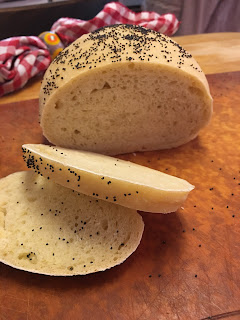Where have I been?
Not to make excuses, but I've been lost in the world of sourdough baking ever since February of 2023, when I created my "Mother" starter. But most of my subsequent sourdough adventure are not Slovenian in origin.
Except for this one, which is long overdue.
This past Christmas, I decided that I would make another attempt at sourdough potica, with my previous recipe (which was adapted from Anita Šumer) as the foundation. Not as a replacement for the beloved family potica--that is a given at Christmas. This would be my "alternative" Christmas offering. In recent years, it has usually been a dairy-free version, to accomodate the dietary needs of a visiting family member. So this one would be two variations in one.
I made a few additional changes to to the earlier sourdough version. beyond the easy substitution of plant-based milk and cream. I decided to make the nut filling a little sweeter and I added a dash of salt. Luckily, I had plenty of walnuts this time. As before, I opted to add a teaspoon of yeast to the dough.
But I really wanted to revisit that sweet stiff starter. I had never made one before, and I had found it so stiff I could barely knead it. And it rose very little.
So I did some online searching and found a few other recipes with slightly different proportions of flour and water--including one that purported to be faster rising--in a recipe for milk bread.
Here is the revised version of that crucial first step:
Sweet Stiff Starter #2.
115 g active sourdough starter
115 g bread flour
45 g water
26 g sugar
Mix all ingredients into a stiff dough. Cover and let rise until doubled.
(I actually made half this amount, which was still more than the 80 grams I needed for the recipe.)
This starter formula had a higher water-to-flour ratio than the the previous one. So it was no surprise that it was much easier to knead. And just as the new recipe promised, it tripled in 4-6 hours.
Nonetheless, the final potica dough remained hard to knead, even with the KitchenAid mixer. I added a little extra liquid--which turned out to be too much. So I had to add a little more flour. Finally, I ended up with something resembling the familiar brioche-type dough.
The final result was tasty enough. But I remain unconvinced that a sweet stiff starter is always preferable in sweeter yeast breads. I see some further experiments in my future!




















